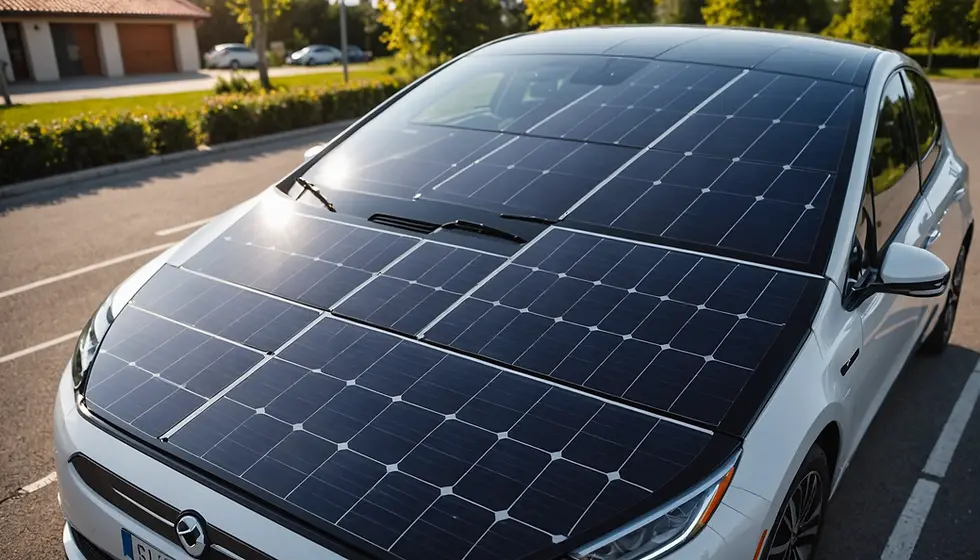Revolutionizing Transportation with Self Charging Electric Vehicles and Energy Autonomy
- Menno Drescher

- Sep 4, 2025
- 4 min read
Transportation is poised for a major transformation, fueled by the pressing need for sustainable solutions to address climate change and diminish carbon footprints. A standout innovation leading this charge is the Self Charging Electric Vehicle (SCEV). This remarkable technology is designed to be energy autonomous, meaning it can generate its own power. In this blog post, we will explore the different energy-harvesting technologies that make the SCEV a revolutionary breakthrough in the electric vehicle sector and how it can redefine how we think about mobility.
Understanding Energy Autonomy
Energy autonomy means that a system can create and use its own energy without needing outside help. For electric vehicles, this translates to the capacity to capture energy from surrounding elements to power itself. The SCEV employs cutting-edge energy-harvesting technologies that continuously collect energy as the vehicle moves, creating a sustainable source of power.
The SCEV utilizes various methods to capture energy, including:
Rotational Energy: This energy comes from the wheels as they turn.
Solar Power: Solar panels on the roof harness sunlight.
Wind Energy: Small turbines capture breeze energy.
Regenerative Breaking.
Suspension Harvesting.
These methods allow the SCEV to recharge its battery constantly, enhancing its energy autonomy and significantly lowering its dependence on conventional charging stations.

The Role of Rotational Energy
A standout feature of the SCEV is its ability to harvest rotational energy produced by the wheels. As the vehicle drives, the wheels turn to generate kinetic energy, which can be converted into electrical energy. This process, called regenerative braking, allows the vehicle to recapture energy usually lost during stops.
For instance, studies show that vehicles equipped with regenerative braking systems can recover up to 70% of kinetic energy during braking. This method significantly increases the driving range, especially in urban settings where stop-and-go traffic is common. By maximizing this energy recovery process, the SCEV not only improves efficiency but also enhances the overall driving experience.
Harnessing Solar and Wind Energy
Additionally, the SCEV features solar panels that convert sunlight into electricity. This abundant source of renewable energy offers a steady power supply during daylight hours. For example, a fully equipped SCEV can generate up to 15% of its energy needs just from solar power on a sunny day, reducing the need for external charging stations.
Wind energy also plays a vital role in the SCEV's design. Equipped with miniature turbines, the vehicle can capture wind energy as it drives. Together, the combination of solar and wind energy allows the SCEV to generate power across different conditions, making it an ideal choice for long-distance journeys and off-grid use.

The Power of Thermoelectric Generators (TEGs)
Thermoelectric generators (TEGs) are crucial to the SCEV's energy system. These devices turn temperature differences into electrical energy. For instance, TEGs can utilize heat from the engine or the road to recharge the battery.
By employing TEGs, the SCEV can convert waste heat into up to 10% additional electrical energy, leading to better overall efficiency. This innovative feature transforms wasted energy into a usable resource, significantly contributing to a sustainable transportation model.
Enhancing Safety and Efficiency with Sensors
The SCEV uses advanced sensors to monitor driving conditions and optimize energy performance. For example, these sensors can detect factors like temperature and wind speed, enabling the vehicle to adjust its energy sourcing in real time.
If sunny conditions are detected, the vehicle will prioritize charging through solar panels. In windy surroundings, it will leverage its turbines. This flexibility ensures that the SCEV operates efficiently no matter the environment.
Additionally, the sensors enhance safety by constantly monitoring the surroundings for obstacles. The SCEV can adapt its driving patterns to avoid potential hazards, protecting both its occupants and others on the road.
Reducing Reliance on External Charging Infrastructure
A significant advantage of the SCEV is its ability to operate without needing constant access to charging stations. Conventional electric vehicles often depend on public charging infrastructure, which may not be available everywhere. In contrast, the SCEV’s self-sufficiency appeals to areas lacking charging stations, empowering more drivers to switch to electric mobility.
In fact, surveys show that nearly 40% of potential electric vehicle buyers are concerned about charging station accessibility. By offering a solution that generates its own power, the SCEV can eliminate this barrier and promote broader adoption.
Adapting to Various Environmental Conditions
The SCEV is engineered for adaptability, ensuring it can perform excellently in various weather and environmental conditions. Whether driving through sunny regions, stormy weather, or elevated temperatures, the SCEV adjusts its energy strategies accordingly.
For example, in sunny deserts, the SCEV can focus heavily on solar energy production, while in coastal areas with strong winds, the vehicle can prioritize harnessing wind energy. This wide-ranging adaptability ensures optimal energy production in diverse climates, maximizing the vehicle's efficiency.
A Promising Solution for Sustainable Mobility
The Self Charging Electric Vehicle marks a significant step forward in electric vehicle technology, offering a promising answer to the challenges of reducing carbon emissions and promoting sustainable transportation. By harnessing multiple energy sources, the SCEV operates independently from traditional charging infrastructure, providing flexibility for eco-conscious consumers.
In a world increasingly focused on climate action, advancements like the SCEV are vital for creating a greener future. By embracing the principles of energy autonomy and self-sufficiency, we can pave a path for a new era in transportation that prioritizes both environmental responsibility and efficiency.
Final Thoughts on Sustainable Transport
The Self Charging Electric Vehicle is truly a transformative concept that holds the potential to reshape how we view transportation. By leveraging various energy sources—including rotational energy, solar and wind power, and thermoelectric generators—the SCEV achieves remarkable energy autonomy, cutting down reliance on charging stations.
With its state-of-the-art sensors and adaptability, the SCEV boosts efficiency while ensuring driver safety. As we work towards sustainable mobility, the SCEV shines as an exemplary innovation, offering a practical path toward greener transportation options for future generations.




Comments